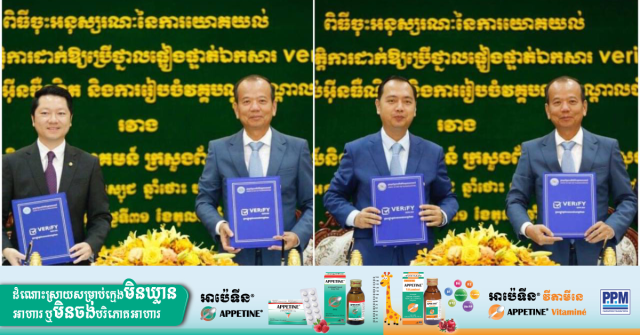Cambodia and China’s Free Trade Agreement Finalized

- Phoung Vantha
- July 29, 2020 5:49 AM
Ministry of Commerce confirms agreement reached, but details and benefits for Cambodia remain unclear.
PHNOM PENH--Secretary of State at the Ministry of Commerce Sok Sopheak on July 28 announced that Cambodia will be able to export more than 340 products to China duty-free now that the free trade agreement (FTA) has been finalized. While not divulging many details, Sopheak noted that Cambodian rice, vegetables, fruit, fish and meat will now be eligible for tax-free exports to China as of 2021.
“We opened the market to China and about 340 goods, about 95 percent [of total export products to China] will be taxed at 0 percent while tax on the remaining 5 percent of goods will, over the course of 10 years, drop down to 0 percent,” he said, but failed to mention what quotas China would apply to Cambodian exports.
Speaking a press conference on July 28, Sopheak noted that most of the products Cambodia hopes to export are agricultural in nature, but declined to give the full list of products as the agreement is yet to be signed.
China will maintain import taxes on Cambodian machinery and vehicle parts in order to better protect the Chinese domestic manufacturing sector, but Sopheak argued that this is not a problem because Cambodia does not produce much of these parts.
Responding to criticism that China will benefit more from the FTA than Cambodia, Sopheak said that no one gets better benefits than each other from that agreement, but was unable to clarify the benefits for either country. He added that Cambodia would need to import goods from China with or without an FTA.
He again reiterated the opportunity that this FTA presents for Cambodia, suggesting that exports to China could increase by as much as 25 percent in the future. He did not say when this may happen or what products would be affected.
“We are not talking about the agreement China has already has with the ASEAN framework, as we have [those agreements] already, so we negotiate to export other goods to China,” he said.
In 2019, Cambodia exported $1 billion’s worth of goods to China, whereas Chinese imports to Cambodia were worth $7 billion. It is unclear which Chinese products or goods will be included in the FTA or how much import duty Cambodia will lose as a result.
The two countries aim to reach $10 billion in trade a year by 2023.
Sopheak was quick to point out that the deal in addition to signing an FTA with China, Cambodia has also lined up negotiations with South Korea, Japan, the United Kingdom, the United States, India, Mongolia and the Eurasian Economic Union. Neither the progress nor the potential of any other FTAs were mentioned by Sopheak.
Senior Researcher at Cambodia-based think-tank the Asian Vision Institute, Chheng Kimlong, said that an FTA between Cambodia and China is more about economic integration within the region, rather than the bartering of goods. This, he explained, was part of the government’s plan to find more trade markets for Cambodia.
“We import only goods that we don't have or we cannot produce or product with high production cost, so we need to import them,” he said. “China is also the same, China will not grow many bananas or mangos, so China has to import.”
Kimlong recognized that meeting the import standards of China will require Cambodia to improve both in terms of technical skill and productivity in order to realize any potential from the FTA with China.
The government has been vocal about its desire to sign the FTA before or on Aug. 12, 2020. This is no coincidence as Aug. 12 is the same day that the European Union is set to apply 20 percent of tariffs on Cambodian exports following a failure to comply with international standards of human and labor rights.
The Everything But Arms (EBA) scheme has become a point of contention in Cambodia, following the EU’s decision to partially withdraw some of the benefits bestowed upon Cambodia through the EBA preferential trading scheme. EBA has benefited the country enormously from duty and quota-free access to European markets, notably garment, footwear and travel goods manufacturing in Cambodia have flourished through preferential access to the world’s largest trading bloc.
However, with EBA set to be partially lost—a decision that may yet lead to further withdrawals of trade benefits from the EU—Cambodia’s government has once more looked to China for support, although it remains unclear who will benefit the most from Cambodia’s new FTA with China.
Kimlong maintained that it is difficult to compare the benefits of the FTA with China and the EBA scheme with the EU, chiefly because the goods exported through each agreement are very different. China will receive more agricultural goods, whereas the EU has predominantly imported garment products from Cambodia.
He urged the government to improve the investment climate and law to attract other investors both foreign and domestic.
While Cambodia remains a largely agricultural country, much of the nation’s economy hinged on garment manufacturing. In 2018 alone Cambodia’s garment exports to the EU were worth $5.4 billion and garment exports to the US were valued at $3.8 billion.
It remains to be seen whether Cambodia’s agricultural sector can compete with the now ailing garment industry, but Sok Sopeak of the Commerce Ministry confirmed that the FTA with China was not a replacement for EBA.















